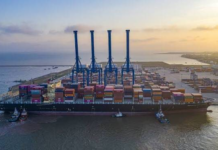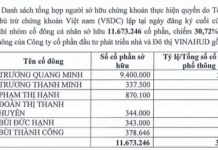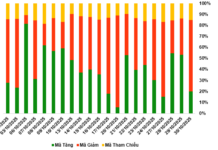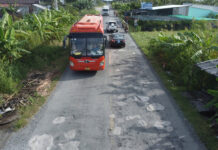VND 106 trillion for 9 key projects in the Mekong Delta
On October 16th in Can Tho city, Prime Minister Pham Minh Chinh chaired a conference to address difficulties and promote the development of transport infrastructure in the Mekong Delta region.
In his opening remarks, Prime Minister Pham Minh Chinh emphasized that the conference demonstrates the government’s commitment to developing strategic infrastructure across the country, with a particular focus on the Mekong Delta.
The Mekong Delta possesses unique potential, outstanding opportunities, and competitive advantages. However, there are bottlenecks and limitations, especially in terms of infrastructure, including transport infrastructure.

Prime Minister Pham Minh Chinh delivers the opening speech at the conference to address difficulties and promote the development of transport infrastructure in the Mekong Delta region. Photo: VGP/Nhat Bac
The limitations in transport infrastructure increase logistics costs, input costs, and reduce the competitiveness of goods. They also fail to create new development spaces and hinder the restructuring of the economy, industrialization, modernization, and the application of science and technology, as well as innovation in the region.
In addition to road projects, the Prime Minister requested discussions on tasks and solutions for the implementation of airport and seaport projects in the Mekong Delta. He specifically instructed the relevant ministries, sectors, and the province of Ca Mau to make efforts to complete the Ca Mau Airport project, with aircraft taking off and landing by April 30, 2025.
“We cannot afford to be slow due to procedural reasons while the people eagerly await and demand the development of an airport,” the Prime Minister stated.
According to a report presented to the Prime Minister by the Ministry of Transport, the Mekong Delta is currently implementing nine important national and key transport projects with a total investment of approximately VND 106 trillion. Among these, eight projects are under construction.
A list of the 9 VND 106 trillion projects that will propel the Mekong Delta forward
Can Tho – Ca Mau Expressway (North-South Expressway, Eastern Section): Including the Can Tho – Hau Giang and Hau Giang – Ca Mau sections
The Can Tho – Ca Mau Expressway has a length of over 110km and a total investment of more than VND 27.5 trillion. It commenced construction in January 2023 and is expected to be completed by 2025.
The expressway consists of two component projects: The Can Tho – Hau Giang section, which is over 37km long with a total investment of more than VND 10.37 trillion, and the Hau Giang – Ca Mau section, which is over 73km long with a total investment of more than VND 17.15 trillion.
According to a report by the My Thuan Project Management Board (the investor), the localities have handed over 99.9% of the site. To date, the construction output has reached 46% of the 57% plan, resulting in an 11% delay.

Can Tho – Ca Mau Expressway Project. Photo: VGP/Nhat Bac
One of the challenges faced by the Can Tho – Ca Mau Expressway is the source of sand for construction. To ensure the mobilization of the remaining sand volume in 2024 (approximately 5.67 million cubic meters), the My Thuan Project Management Board proposed that the Ministry of Transport consider and continue to urge the localities (Vinh Long, Ben Tre, An Giang, Dong Thap, and Tien Giang) to expedite the completion of procedures for sand exploitation and to increase the capacity of sand mines to adequately supply sand for the project.
In terms of capital disbursement, 79% of the planned amount has been disbursed for 2024. The cumulative disbursement from the beginning of the project to the present is 92%.
Chau Doc – Can Tho – Soc Trang Expressway: Comprised of 4 component projects
The Chau Doc – Can Tho – Soc Trang Expressway Phase 1 has a total length of 188km and passes through four provinces and cities: An Giang, Can Tho, Hau Giang, and Soc Trang. With a total investment of over VND 44 trillion from the central and local budgets, it is expected to be completed by 2026.
In Phase 1, the project is invested in a phased manner with a scale of four lanes and a designed speed of 100km/h. In the completion phase, the expressway will be expanded to six lanes.
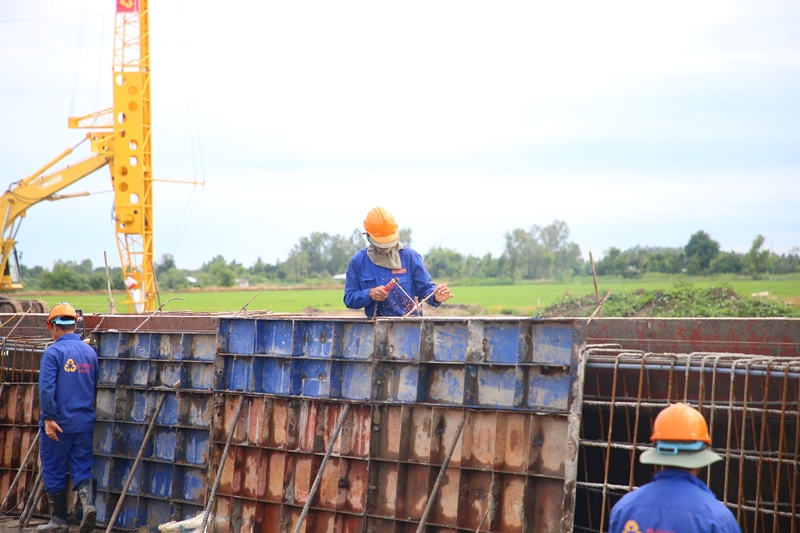
Construction workers on the Chau Doc – Can Tho – Soc Trang Expressway. Photo: Communist Party of Vietnam Online Newspaper
The project is divided into four component projects, each managed by the respective local authorities through which the expressway passes. The first component project in An Giang province is 57.2km long, the second in Can Tho city is 37.2km long, the third in Hau Giang province is nearly 37km long, and the fourth in Soc Trang province is 56.9km long.
Cao Lanh – An Huu Expressway: Comprised of 2 component projects
The Cao Lanh – An Huu Expressway Phase 1 project was approved by the Prime Minister in Decision No. 769/QD-TTg dated June 24, 2023, and the adjustment of the investment policy was approved in Decision No. 1640/QD-TTg dated December 19, 2023. The preliminary total investment is VND 7,496 billion, including two component projects.
The first component project, located in Dong Thap province, is approximately 16km long, with a preliminary total investment of VND 3,640 billion, and is managed by the People’s Committee of Dong Thap province.

Groundbreaking ceremony of the Cao Lanh – An Huu Expressway (Component 1). Photo: Ap Bac Newspaper
The second component project, located in Dong Thap and Tien Giang provinces, is approximately 11.43km long, with a preliminary total investment of VND 3,856 billion, and is managed by the People’s Committee of Tien Giang province.
The starting point of the second component project is at Km16+000 in My Hiep commune, Cao Lanh district, Dong Thap province, and the endpoint is at Km98+950 (about 1.8km from the An Thai Trung intersection) in An Thai Trung commune, Cai Be district, Tien Giang province.
My An – Cao Lanh Expressway
The My An – Cao Lanh Expressway, with ODA funding from South Korea and managed by the Ministry of Transport, is currently finalizing procedures and is expected to commence construction in early 2025.
The expressway is approximately 26.6km long, starting at Km96+875 in My An town, Tháp Mười district, Dong Thap province, and ending at An Binh intersection (Cao Lanh bridge) in Cao Lanh district, Dong Thap province.
In Phase 1, the My An – Cao Lanh Expressway will be constructed with a roadbed width of 17m and four lanes. Emergency stopping bays will be arranged intermittently with a distance of 4-5km per location. The service roads will be built with a minimum roadbed width of 5m.
In Phase 4, the project will be implemented with a scale of four lanes but will acquire land with a width of six lanes in accordance with the approved planning.
Ho Chi Minh Road, Rach Soi – Ben Nhat and Go Quao – Vinh Thuan sections
The project has a total length of approximately 51.94km, including the Rach Soi – Ben Nhat section, which is 11.2km long, starting at Km 0+000 (Km 88+540 QL61) in Chau Thanh district and ending at Km 11+200 (Km 77+00 QL61) in Giong Rieng district, Kien Giang province.
The Go Quao – Vinh Thuan section is 40.74km long, starting at Km20+600 (Km 67+213 QL61) in Go Quao district and ending at Km 61+342 (Km 67+174 QL61) in Vinh Thuan district, Kien Giang province.
The project has a total investment of over VND 3,904 billion from the state budget and is managed by the Ho Chi Minh Road Project Management Board. It is expected to be substantially completed by 2025.

The route of Ho Chi Minh Road, Rach Soi – Ben Nhat and Go Quao – Vinh Thuan sections (red circle) in Kien Giang and Bac Lieu provinces. Photo: Draft Map of National Technical Infrastructure Development
Cao Lanh – Lo Te Project
The Cao Lanh – Lo Te Project involves the upgrading of a 28.8km section of the Cao Lanh – Lo Te route in the provinces of Dong Thap and Can Tho, with a total investment of approximately VND 950 billion. Construction began in late April 2024, and the project is expected to be completed and put into operation by December 31, 2025.
The project aims to improve traffic capacity and meet the transport needs along the western axis of the region, maximizing the efficiency of investment projects in the area.
The starting point of the project is at the An Binh intersection, My An commune, Cao Lanh district, Dong Thap province (approximately Km 26+00 according to the route’s kilometer markers), and the endpoint connects with the Lo Te – Rach Soi route at approximately Km 54+844 in Can Tho city.
Lo Te – Rach Soi Project
The Ministry of Transport has approved the investment in the Lo Te – Rach Soi route upgrade project in Can Tho city and Kien Giang province, with a total investment of approximately VND 750 billion.
The project is expected to be completed and put into operation before December 31, 2025. The My Thuan Project Management Board has been assigned as the investor and is responsible for managing the project to ensure its completion within the timeframe approved by the Ministry of Transport.

Construction of the Lo Te – Rach Soi route. Photo: Giao Thong Newspaper
The Lo Te – Rach Soi route in Phase 1, with a length of 51.5km and a roadbed width of 17m, consisting of four lanes, was completed and put into operation in January 2021. It was implemented with capital from the EDCF fund of the Korea Economic Development Cooperation Fund.
The starting point of the project is at Km02+104.11 in Vinh Thanh district, Can Tho city, connecting with the Vam Cong Bridge project, which has been completed and put into operation. The endpoint is at Km53+553 in Chau Thanh district, Kien Giang province, connecting with the Rach Gia bypass project.
Rach Mieu 2 Bridge Project
The Rach Mieu 2 Bridge is the seventh bridge over the Tien River, following the Rach Mieu, Cao Lanh (Dong Thap), My Thuan (connecting Vinh Long and Tien Giang), My Thuan 2, and Ham Luong (Ben Tre) bridges, and the Co Chien Bridge (connecting Ben Tre and Tra Vinh).
With a total investment of VND 5,200 billion, later adjusted to over VND 6,800 billion, the 17.6km-long bridge connecting Tien Giang and Ben Tre provinces commenced construction in March 2022 and is expected to be completed in three years. Located about 4km from the existing bridge, the new bridge will help reduce congestion, especially during holidays and Tet.

A bird’s-eye view of the Rach Mieu 2 Bridge project, connecting a continuous route from Tien Giang to Ben Tre province. Photo: VGP/Nhat Thy
Dai Ngai Bridge Project
The completion of the Dai Ngai Bridge project, spanning the Hau
Accelerating Vietnam’s Infrastructure Dream: 600km of Expressways in the Mekong Delta by 2025
On October 16th, Prime Minister Pham Minh Chinh chaired a conference in Can Tho to address challenges and promote the development of transport infrastructure in the Mekong Delta region.
The Expansive Vision: Upgrading Ca Mau Airport for a Brighter Future
Vice Prime Minister Tran Hong Ha has approved the investment policy for the expansion and upgrade of Ca Mau Airport (the “Project”). This decision, outlined in Resolution No. 1188/QD-TTg, dated October 15, 2024, marks a significant step forward in the development of the aviation industry in the Ca Mau province.
Mobilizing Over 6,500 Workers and 2,200 Equipment, Most Transport Projects in the Mekong Delta Are Still Delayed by 4-15% Due to One Main Reason
The Mekong Delta region is currently undertaking 9 critical national transportation projects with a total investment of 106,000 billion VND. 8 out of 9 projects are under active construction, while the My An – Cao Lanh Expressway project, funded by Korean ODA, is finalizing procedures and is expected to break ground in early 2025.
“Capital Investment Adjustment Proposal for the Capital Region’s Ring Road 4 Project”
On the morning of October 3rd, Deputy Prime Minister Tran Hong Ha met with the People’s Committee of Hanoi and the provinces of Hung Yen and Bac Ninh, alongside relevant ministries, to discuss the progress of the construction investment project for the Capital Region’s Ring Road 4.
Expanding Ca Mau Airport to Welcome 1 Million Annual Visitors with an Investment of Over 860 Billion VND
The Vietnamese province of Cà Mau is set to invest over 860 billion VND in a game-changing infrastructure project. With a vision to transform local connectivity, the funds will be utilized to acquire land and embark on an ambitious expansion of the Cà Mau Airport. The project aims to elevate the airport’s capacity to accommodate 1 million passengers annually, setting a new benchmark in regional aviation and unlocking unprecedented growth opportunities.













